Below is a collection of student work from throughout the semster. Included are images of classroom activities, as well as individual and team assignments.
PROVOCATION 03: In this design prompt students were challenged to exlore designs focused on the body. (FULL VIDEO PLAYLIST)
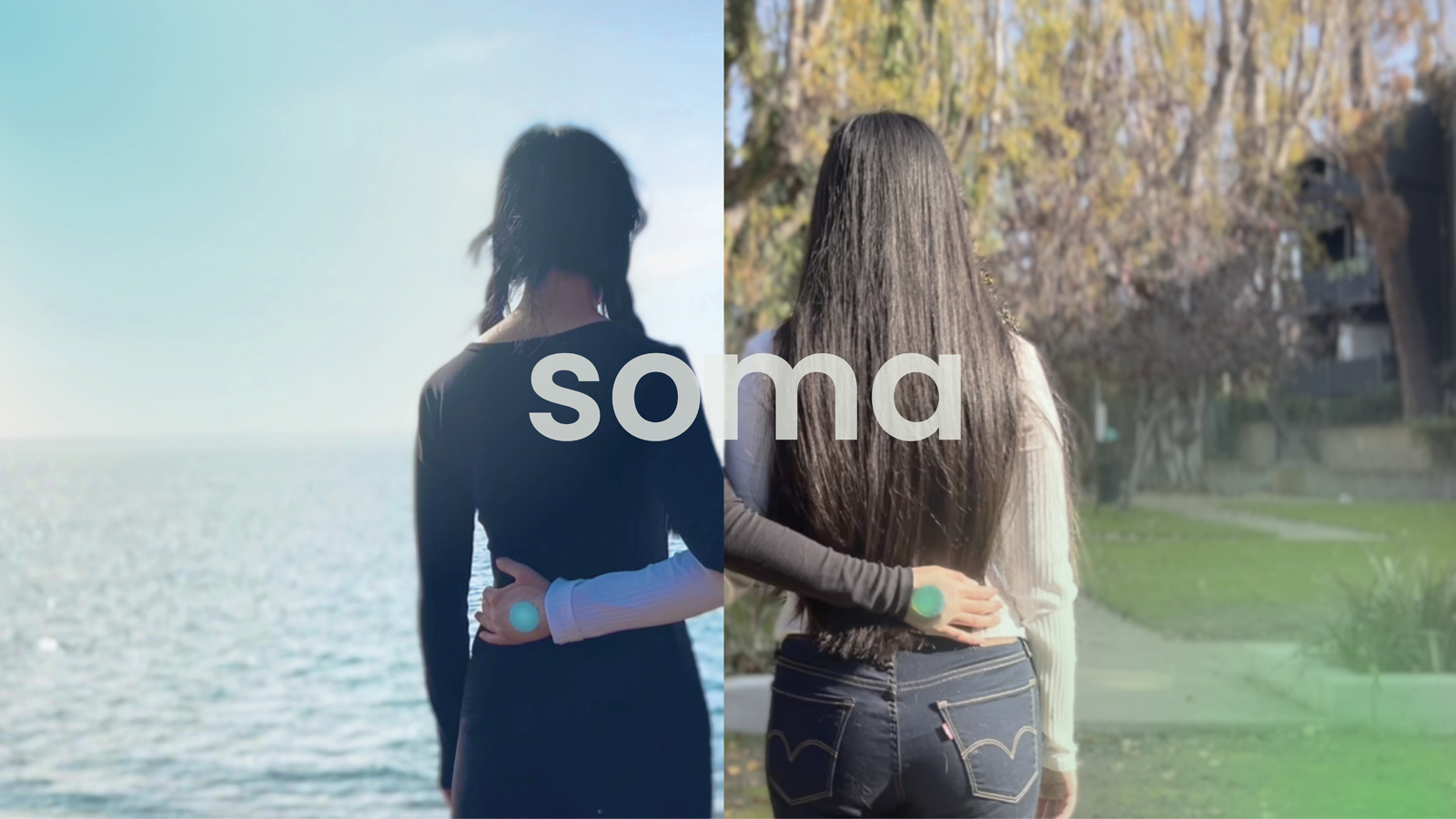
Luna Wang, Susanne Pierce Maddux, Yu Cheng, Georgios Grigoriadis
soma is a wearable device, shared by two people. soma’s two way communication of subtle outputs of warmth, vibration and light is designed to foster therapeutic remote physical communication of care and empathy. soma’s experimental and revolutionary two way haptic communication mode is designed to provoke a positive psychological response of well being and support between two people that transcends the act of texting. Much like texting and emojis, soma sets the stage for the development of user generated haptic communication vocabularies.
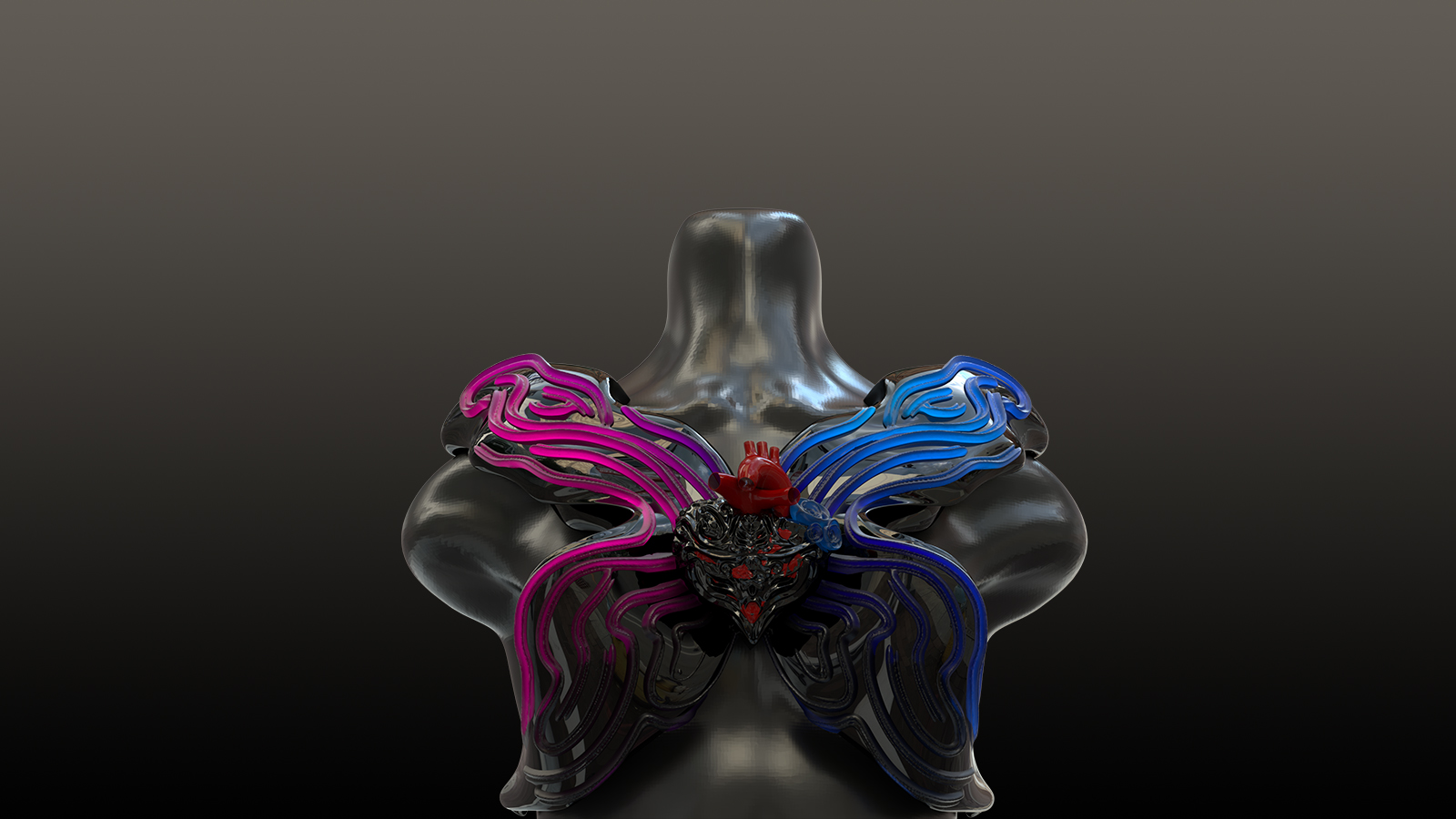
Adam Huth, Abhi Ghavalkar, Penny Lin, Yiying Wu
Socialization is at the heart of human nature, and each day, we interact with others through conversation, leisure, and work. Every word we exchange carries emotion, and that emotion affects those around us in invisible ways. Vitals renders the unseen visible, using color to visualize both positive and negative conversation, acting as an early warning sign for long-term exposure. When exposed to too much negativity, "tumors" begin to form on a heart at the center of the wearable, a permanent reflection of the emotional spaces you inhabit. The wearable uses Natural Language Processing (NLP) to calculate a sentiment score for the conversations the wearer has, which triggers a heating element that acts as a catalyst for thermochromic pigments and ink that puffs under heat.
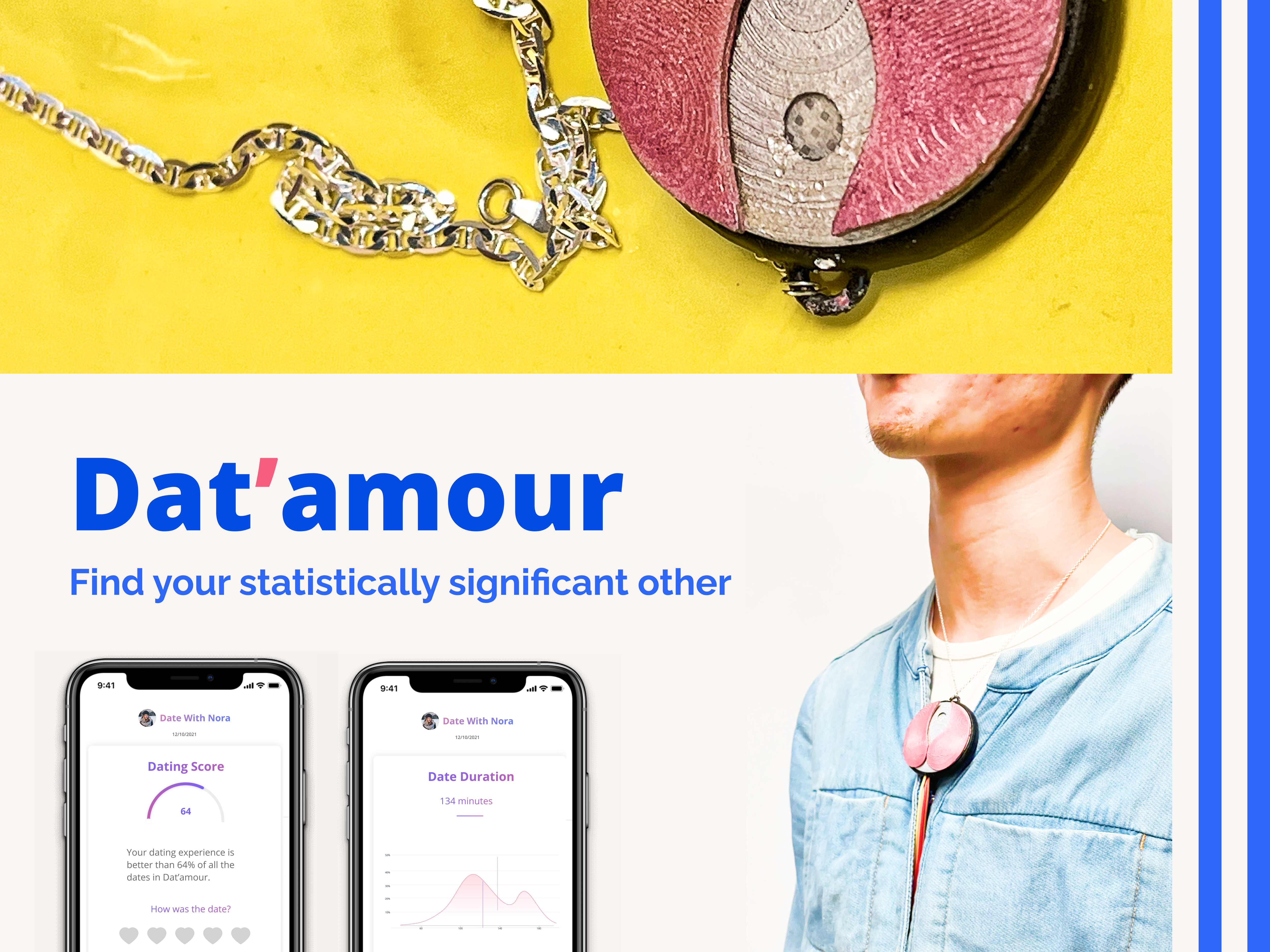
Ted Huang, Jiaxuan Ren, Shuyang Yu, Kailin Li
Our project is motivated by the increasing use of dating apps to meet potential partners. These websites and applications already leverage information input by users to provide them with a myriad of options. Yet the actual experience of dating still remains complicated, awkward, elusive, and at times frustrating as we get to know another person on an intimate level. We speculate upon whether this process can / should be "optimized" or "enhanced" by providing users with data and real-time feedback immediately before, during, and after going on a date. It asks the question of the role that artificial intelligence can play in some of our most intimate and private moments. We position ourselves as a start-up in the the near possible future offering a more efficient and effective dating platform. The users will be more aware of their dating mishaps as the date is happening, so they have a chance to course-correct. The wearable will also allow the opposite party to see whether they're contributing meaningfully and positively towards the conversation.
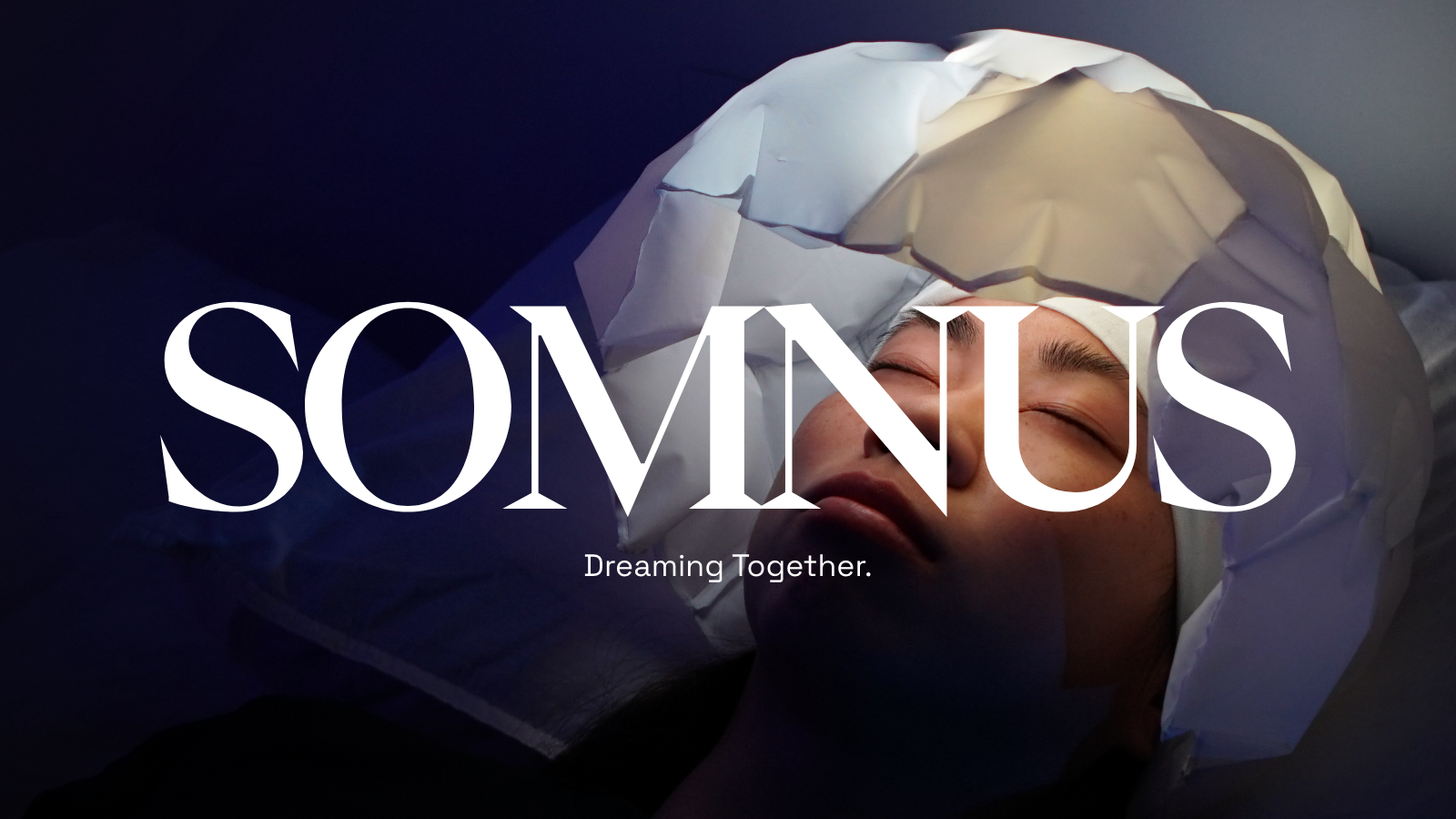
Effie Jia, Titus Ebbecke, Xiaobai Ji, Xinyi Zhu
sWe imagine a dystopian future world where human beings are burnt out and overwhelmed by endless work and production, ultimately sacrificing genuine connection with loved ones, friends, and strangers. Stress and exhaustion are no longer just personal experiences, but unstoppable phenomena for humanity. Somnus is a regulated panacea in response to the deteriorating society—one that is myopically career- and productivity-driven to the point of near collapse. In this speculative fiction, Somnus is an inflatable device worn on the head. It is equipped with LEDs, air pumps, peltier coolers/heaters, and bone conduction transducers, which work in concert to induce synchronized, lucid dreaming between two or more people. Though the world-building is speculative, the technology is based on current research surrounding lucid dreaming. Wearers choose dreams to “join” each night and are able to connect with others through synchronization while they sleep.
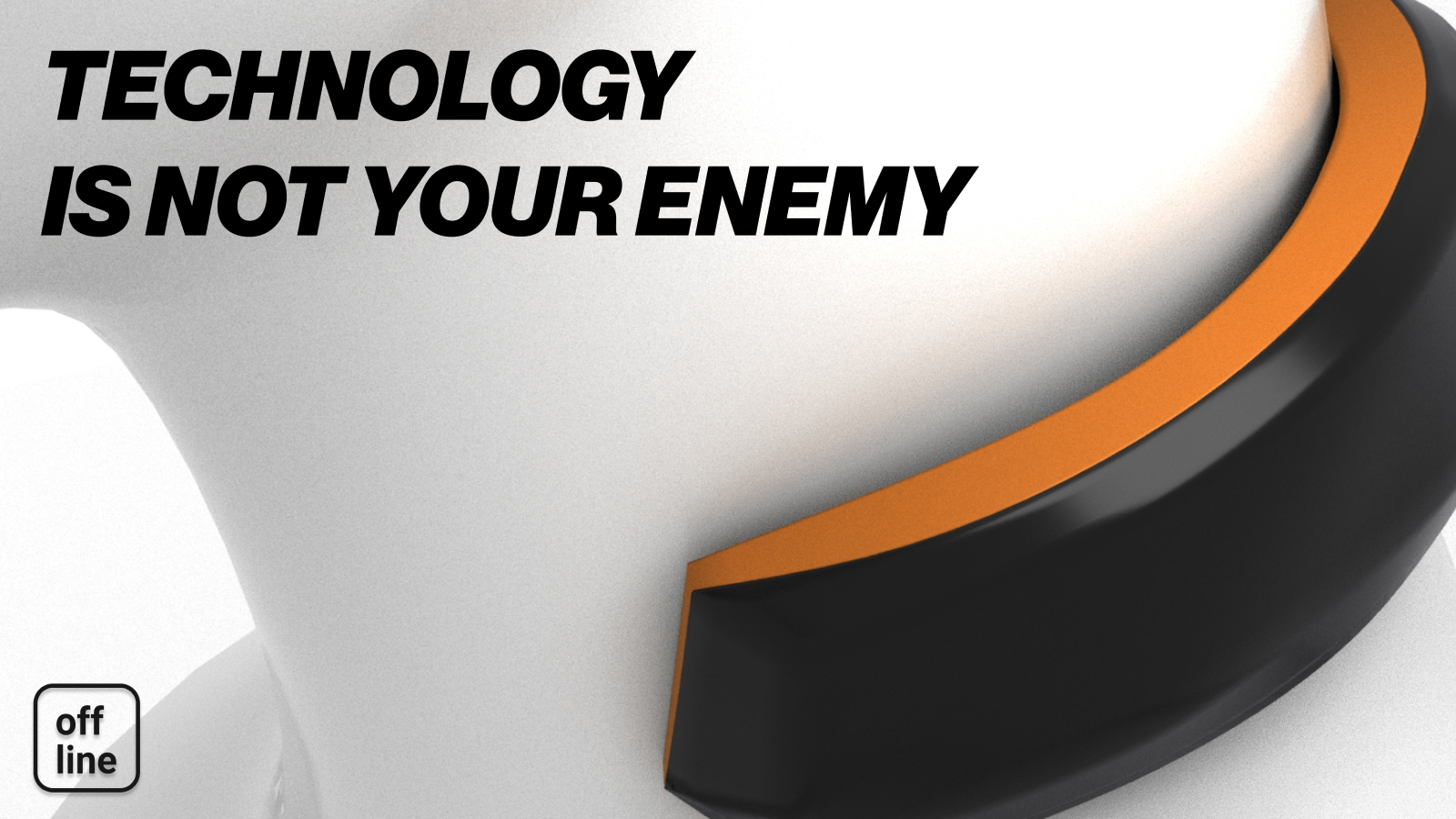
David Zhou, Elijah Lee, Franklyn Bucknor, Jan Veicht, Mercedes Saldana
As a species newly introduced to technology, homosapiens struggle with regulating their time spent with their digital extensions. This has led to various modes of addiction to technology; with the most pervasive stemming from an individual’s feelings of Nomophobia— or fear of being without a mobile device. Symptoms include: 1) Inability to travel anywhere, even short distances, without one’s smartphone. 2) Compulsive seeking of, or operation of, one’s smartphone without conscious intention. 3) Doomscrolling. In response, we have created OFF-LINE. OFF-LINE exists as the most prescriptive in a tiered ecosystem of wearables offered by self help groups for excessive technology use (SHESUs). Each wearable features the next generation of electroshock therapy, made possible by OFF-LINE's patented PixelWatt voltage delivery system. In moments where individuals act on their addiction, they are greeted with adaptive, non-lethal doses of electricity which studies have shown to assist individuals with overcoming their addiction or compulsive disorders 300% faster than other methods, with a relapse rate of 0.0%.
PROVOCATION 02: In this design prompt students were challenged to augment a 21 x 21 x 21 foot cubic public space. (FULL VIDEO PLAYLIST)
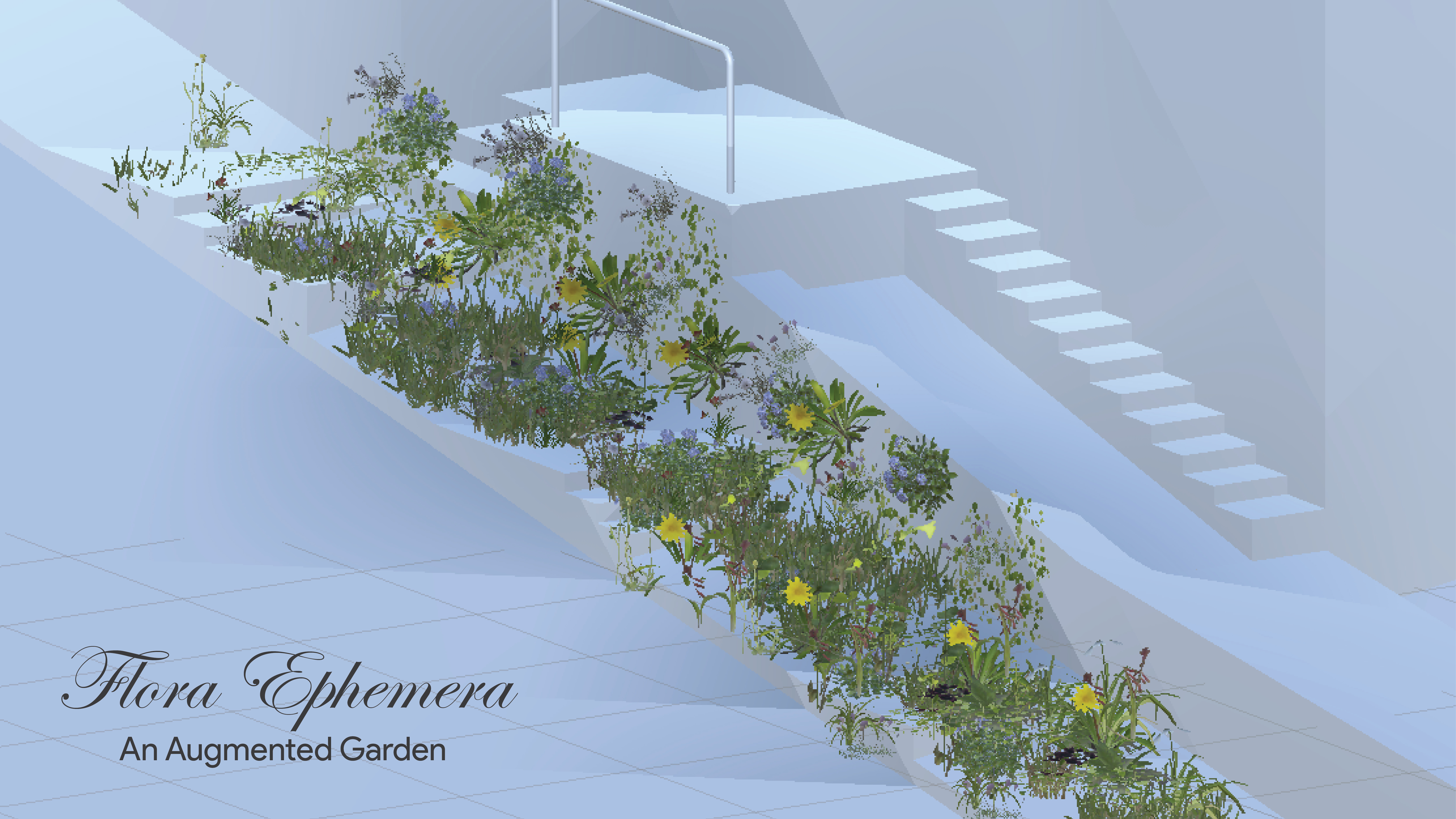
Abhi Ghavalkar, Georgios Grigoriadis, Effie Jia, David Zhou
Berkeley has a network of public paths, steps, and walkways that are removed from the bustling world they exist within. Though they can be natural reprieves from the pace of modern life, people primarily use them as a shortcut to get to public transportation, shopping districts, and schools. Flora Ephemera is a digital experience that uses augmented reality to help passersby slow down and enjoy the gorgeous, green corridors created by the Berkeley Pathwanders’ Association. The augmentation technology spawns flora native to the region at a rate that corresponds to the speed at which the user traverses through the space. Flora Ephemera’s experience begins at the bottom of the steps and progresses as the user ascends the stairway. The program was designed specifically for a 21x21x21-foot space within the Hill Court Steps that connect Le Roy Avenue to Hill Court in the North Berkeley Hills.
Map to location of selected site
37° 52' 48.1" N, 122° 15' 37.0" W

Eli Lee, Susanne Maddux, Jan Veicht, Xiaobai Ji, Xinyi Zhu
The FABLE Albany Bulb augmented reality experience allows visitors to digitally create and contribute art within the practice of the existing found art culture of Albany Bulb. At our specific site, we invite visitors to explore and create digital artifacts by using the existing physical found art artifacts and natural elements of the landscape. Within our digital AR experience, visitors create unique and colorful animals based on native California creatures.
Map to location of selected site
37° 53' 24.6444" N, 122° 19' 32.9514" W

Titus Ebbecke, Mercedes Saldana, Shuyang Yu, Franklyn Bucknor
Growing Young is an AR experience that seeks to reintroduce adults to the wonder and awe that we experienced as children existing in a time when the world was an enchanted playground; when rocks were gems, flowers were invitations, and every day an adventure. The magic world we’ve built is not revealed to individuals who are adults -- not until they’ve physically lowered themselves to the height of a child. By forcing this interaction, individuals contort themselves into a form that is reminiscent of childhood; their proximity to the nuances of the world is increased and minutiae of their surroundings that were once relegated to the background become focal points in the foreground. At this point, the world becomes new, much like it was new every single day as a child: mystical flowers bloom, forest animals make their presence known, and hidden treasures excite feelings of adventures untold.
Map to location of selected site
37° 53' 12.465" N, 122° 15' 43.9374" W
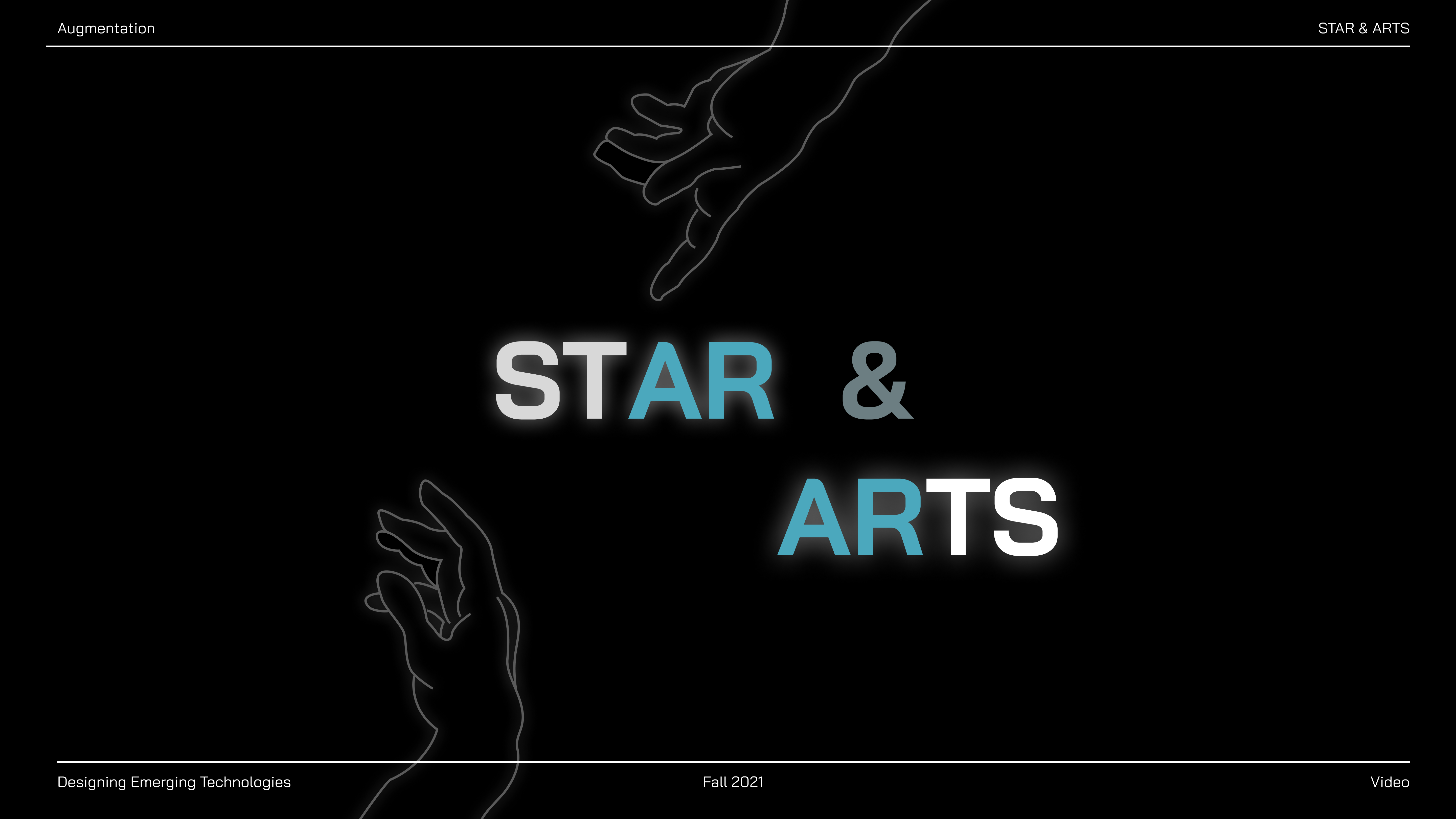
Adam Huth, Jiaxuan Ren, Kailin Li, Ted Huang
STAR & ARTS is an augmented reality exhibition experience design built in the context of Berkeley Art Center around a firepit. After our team decided that we wanted to build a public art exhibition launched with an event, we then had to begin community-made artworks. We chose to use Airtable for its form and database capabilities - as we collect more artworks, we can eventually connect the database to our Unity project. On the form, we asked participating artists to submit artwork relevant to one of our selected themes. Along with allowing them to submit artwork in a variety of formats (photograph, video, 3D models, audio, etc.), we allowed the artists to provide their bio and information about the piece. From there, we collected additional background info, such as location within Berkeley.
Map to location of selected site
37° 53' 3.4038" N, 122° 16' 5.2746" W

Yiying Wu, Peipei (Penny) Lin, Zhiyue (Luna) Wang, Yu Cheng
‘Stage X' is an AR immersive event designed for the tourists and the local communities to experience the beauty of San Francisco. By interacting and scanning the cut-up pieces of the SF map that are placed on the tiles, a corresponding landmark model and a sound effect will appear. After the audience has completed their scanning tour, they will be randomly awarded a landmark model (like opening a mystery box) together with the compiled music of their journey as souvenirs. Next, the participants or audiences can scan the Dewey monument to discover what others received. When scanning, it will show up as a tree with all the awards hanging on it. At the end of this journey, guests can take a photo with the virtual tree and share it with their friends or on social media for to commemorate this event.
Map to location of selected site
37° 47' 16.8108" N, 122° 24' 25.3152" W
PROVOCATION 01: In this project, students designed and prototyped a novel object within the landscape of a "counter". These objects embody elements of perception and interaction. Students were free to choose any counter – your own kitchen counter, a neighborhood cafe counter, a workshop counter, etc. (FULL VIDEO PLAYLIST)

Adam Huth, George Grigoriadis, David Zhou, Penny Lin
Muto 21 is a speculative design that envisions an open-market vendor interaction in a future where computer vision has become a broadly accessible, familiar technology to the general population.In this future, the lines between personal and public data is blurred, with formerly unprecedented amounts of private citizen’s digital fingerprint accessible in public domains. The societal messaging surrounding personal data is one of “Increased transparency = Increased accountability.” Digital data collection and processing has infiltrated every corner of public life -- even utilized in the traditionally analog, untechnological setting of a market vendor counter. MUTO21 aims to provoke us to ask questions about the current trajectory of big data, people’s digital fingerprint, and our relationship with the data we produce. An artifact to explore the implications.

Susanne Maddux, Mercedes Sauceda, Xinyi Zhu, Abhi Ghavalkar
Lyric is a musical instrument designed to enhance social engagement around the environment of the dining counter; it uses vision technology to bring people together. In an increasingly dividing world, where technology isolates people, Lyric explores how technology could be used to enhance the human senses and bring joy using a playful twist on machine vision. Your friends and family can pass around the Lyric product just as they would a pepper mill over dinner. The device creates music using a sequence of sounds generated after scanning food, with the help of real-time object detection and color recognition.

Elijah Lee, Jan Veicht, Shuyang Yu, Jiaxuan Ren, Ted Huang
Mono is a tabletop device that utilizes Computer Vision to augment the experience of encountering crafted artifacts. Our design recognizes objects via different positionings on a simple 'timeline' area. In our prototype, three discs define the product 'timeline' and present the background information; the art of craft, the artist's intention, and a detailed look at the manufacturing processes. We not only imagine our product as a great addition to any existing sales counter in the retail environment but also foresee possible incorporation into educational settings such as museum exhibitions. The stories Mono shares with the future users (or customers) augment and highlight each crafted process behind an object. We believe Mono creates a more intimate connection and interaction between customers and crafted artifacts through our device. More importantly, however, Mono gives context and space to the human factor behind the objects and tangible artifacts of daily use.

Titus Ebbecke, Yiying Wu, Zhiyue Wang, Xiaobai Ji
Boo Hoo is a portable baby diaper changing counter with a built-in avatar. Users can find the nearest Boo Hoo in the app anytime and anywhere, open and plug in their phones, and Boo Hoo will run automatically. Gaze tracking enables Boo Hoo to follow the baby’s gaze, while facial expression detection can respond to babies’ emotions so that the avatar can interact and play with the baby. Boo Hoo will also monitor the baby's heart rate, weight, and other health information. Let the baby be engaged with Boo Hoo, and parents can change their diapers at ease. What’s more, Boo Hoo sterilizes itself with UV, and it will run automatically when the case is closed. Boo Hoo is designed to make one of the most essential acts of parenthood more comfortable and less stigmatized for parents, bystanders, the baby itself. Enjoy the magic of raising life with Boo Hoo.

Effie Jia, Franklyn Bucknor, Kailin Li, Yu Cheng
By creating Musee, we want to call into question our habit of documenting and sharing our memorable moments with our social media network. Instead of being able to constantly serve each other and exchange experiences on-the-go via digital counters, our counter is off-grid and stationary. Musee aims to facilitate and preserve compositions co-created by the user and the environment. Musee is an invitation for human to be in tune with their surroundings and their own mental state by connecting visuals and sounds.
